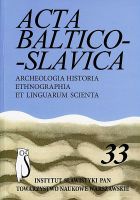Od pisowni gotyckiej do łacińskiej – droga przemian
Ways to the Change of Orthography: from gothic to Roman characters
Author(s): Ilga JansoneSubject(s): Language and Literature Studies
Published by: Instytut Slawistyki Polskiej Akademii Nauk
Keywords: Latvia; orthography; changes; Gothic script (Fraktur); Latin script (Antiqua).
Summary/Abstract: On January 25, 1908, an Orthography Commission was founded at the Science Union of the Latvian Society with Kārlis Mīlenbahs as a chairman. On June 17, 1908, the Orthography Commission held a convincing vote for the new orthography. The main principles of this new orthography can be characterised by the following traits: use of Roman letters in print; dropping “h” as a lengthening mark; all long vowels must be denominated with a horizontal dash notwithstanding their position; diphthongs ie and o must be denominated according to the Lithuanian model – ie and uo; cluster letters sch, zch, tsch must be discarded; palatal consonants must be denominated by a mark above or a comma under the respective consonant; w must not be used in any position. Starting with 1909, this orthography was taught at schools. In 1919, an instruction was passed by the Commissariat of Education “On the Latvian Language Writing at Schools” accepting the 1908 orthography with a single exception – the diphthongs ie and o had to be written as ee and o. During the 20-ies and 30-ies of the 20th century the consolidation process of this orthography in writing was going on. The first authors in the 16th century of the books written in Latvian were German clergymen who moulded the Latvian writing according to their German reading and writing skills. The main features of this orthography were the Gottic letters, “h” as a lengthening mark, the so called “cluster letters” for indicating the consonants š, ž, č, differences in the reproduction of diphthongs, for example “ee” and “o” and an immense inconsistence all in all. Several rather successful attempts to improve the Latvian writing were made as early as in the 17th–18th century (Georgs Mancelis, Kristofors Fīrekers, Heinriks Adolfijs, orthography sessions for the second edition of the Bible), but they mostly concerned the changes in sound denominations. The possibility to change the Gothic type for Roman letters was not discussed. In 1847, the Latvian doctor Juris Bārs initiated essential changes in the writing of the Latvian language. He had the following proposal: to use Roman letters; to denominate the long vowels with two types of lengthening marks depending on intonation; to denominate the diphthongs ie and uo with ia and ua; to denominate the letters s, z, c with Roman letters, but to reflect the palatal consonants by crossed respective consonant letters; to retain w. In 1876 the Science Union of the Latvian Society elaborated an orthography of its own containing the following proposals: to use Roman letters, to denominate the sibilants š, č, ž with a mark above the letters, to denominate the palatal consonants ļ, ņ, ŗ, ķ with a comma mark under the letters, to abandon intonation differences in the denomination of long vowels, to retain the reflection of the diphthong ie by ee...
Journal: Acta Baltico Slavica
- Issue Year: 2009
- Issue No: 33
- Page Range: 13-28
- Page Count: 16
- Language: Polish

